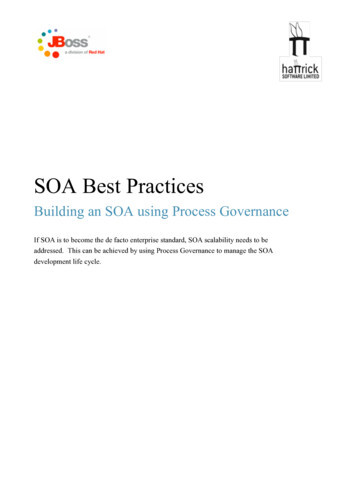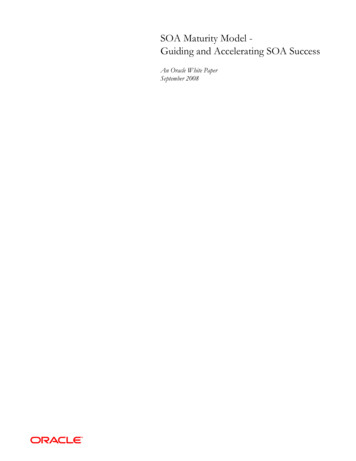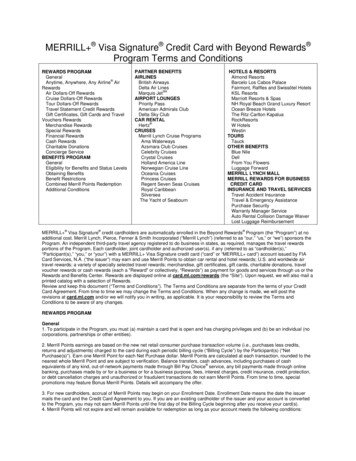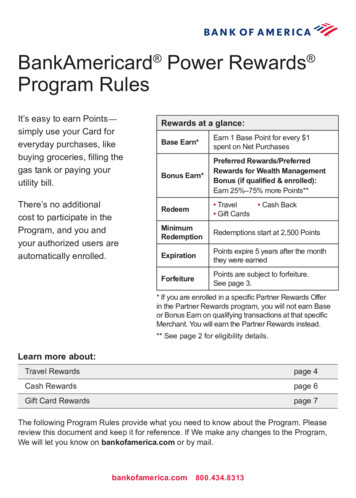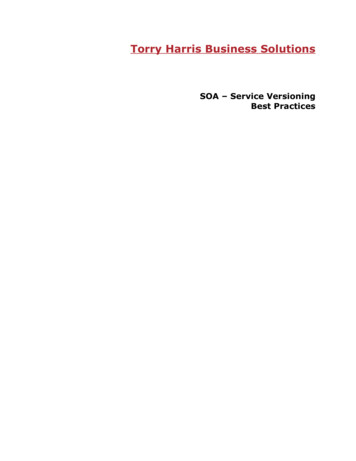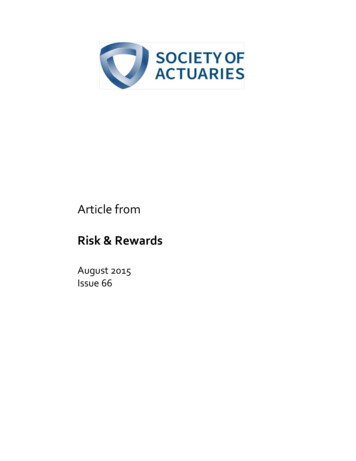
Transcription
Article fromRisk & RewardsAugust 2015Issue 66
On The Importance OfHedging Dynamic LapsesIn Variable AnnuitiesBy Maciej Augustyniak and Mathieu BoudreaultVariable annuities (U.S.)and segregated funds(Canada) are life insurance contracts offering benefitsthat are tied to the returns of areference portfolio. These policies include various forms ofcapital and income protectionin the event of market downturns such as a guaranteed minimum death benefit (GMDB)or a guaranteed minimumwithdrawal benefit (GMWB).An important feature of variable annuities is the possibilityfor the policyholder to lapse orsurrender the contract. In thelatter case, the policyholdergives up the underlying insurance protection, ceases to payfees to the insurer and receivesa surrender value. Lapse assumptions are critical inputs inpricing and hedging models ofvariable annuity guarantees andcan be divided into two types:deterministic (or static) anddynamic lapses (see Eling andKochanski, 2013, for more details). Deterministic lapses aredue to unforeseen events in thepolicyholder’s life (for example,loss of employment creatingliquidity needs) and are generally seen as diversifiable. Onthe other hand, dynamic lapsesresult from an investment decision on the part of the policyholder. For instance, when theguarantee is deep out-of-the-12 AUGUST 2015 RISKS & REWARDSmoney, the policyholder hasa strong incentive to lapse thecontract and choose an alternative investment product. Thisis simply because the insured ispaying high fees (fees are generally deducted in proportionto the sub-account’s value) fora guarantee that is very unlikely to be triggered in the future.Therefore, dynamic lapses aregenerally driven by the moneyness of the guarantee and sincethe evolution of markets affectsmost VA contracts in a similarfashion, these lapses are clearlyvery difficult to diversify.There is growing evidence thatdynamic lapsation is importantto take into account in variable annuities. For example,Milliman (2011) and Knolleret al. (2015), found a strongstatistical relationship betweenlapse rates and the moneynessof the guarantee in empiricaldata. Moreover, the CanadianInstitute of Actuaries (2002)and the American Academy ofActuaries (AAA) (2005) bothrecommended to take dynamic lapsation into account byvarying the lapse rate with themoneyness of the guarantee.According to a survey from theSociety of Actuaries performedin 2011, approximately 60 percent and 80 percent of participating insurers followed thispractice when modeling deathand living benefits, respectively.maturity, he is entitled to max(AT,G) at time T where G denotes the amount of the guarantee (for a return-of-premiumguarantee, we have G A0). IfAT G, the guarantee maturesin-the-money and the insureris responsible for the shortfall,i.e., its liability is the payoff of aput option: max(G - AT, 0).The objective of this article isto investigate the importanceof hedging dynamic lapses invariable annuities. More precisely, we aim to answer onevery practical question, that is,what is the impact on hedgingeffectiveness when an insurancecompany chooses not to hedgedynamic lapses, or alternatively, to hedge them but with thewrong assumptions.If the policyholder surrendershis contract at any time priorto the maturity of the policy,he receives the balance of thesub-account value minus a surrender charge which we suppose is expressed as a fraction κK of At. Therefore, the surrender value at time t correspondsto At(1-K).GMMB CONTRACTSuppose that an insured investsin a guaranteed minimum maturity benefit (GMMB) product with a set maturity T. Thesub-account value is creditedwith the returns of an underlying reference portfolio andfees are continuously deductedfrom the sub-account as a percentage of the account balance.Denoting the value of the reference portfolio at time t by St,the sub-account value at time tis given byDECOMPOSITION OFTHE PAYOFF TO THEPOLICYHOLDERWe integrate dynamic lapsationinto the GMMB contract byassuming that the policyholderwill surrender his contract atthe first moment (before maturity) the sub-account valuenet of surrender charges hits apredetermined barrier knownas the moneyness thresholdor level. We will use the termmoneyness ratio when thismoneyness threshold is expressed relative to the guarantee G. Table 1 shows that theAt St e-atwhere a is the aforementionedannual fee rate, and A0 S0 isthe initial investment.If the policyholder does notsurrender his contract beforeTable 1Decomposition of the payoff of a GMMBcontract with dynamic lapsation riskComponents of theportfolioBarrier is hit beforematurityBarrier is not hitbefore maturity(I) Up-and-out put0max(G - AT,0)(II) Rebate optionMoneyness level paidupon surrender00ATMoneyness level paidupon surrendermax(AT, G)(III) Up-and-out callwith zero strikeTotal payoff
The decomposition presentedin Table 1 renders the analysis of the GMMB producttractable because closed-formexpressions for each of the underlying options are availableunder the Black-Scholes model(see McDonald, 2006, Section22). Therefore, the valuationof a GMMB contract (from afinancial engineering perspective) under dynamic lapsationrisk and the computation ofGreeks required for establishing a dynamic hedging strategy are both straightforward toperform.FAIR FEEHaving decomposed the payoff to the policyholder into abasket of barrier options, wenow focus on how to computethe fee rate for the GMMBcontract. Defining the insurer’s net liability as the payoffof the contract net of fees andsurrender charges, we say thatthe fee is fair if it is determinedsuch that the net liability of thepolicy is zero at inception of thecontract. This is similar to theequivalence principle in actuarial mathematics.To analyze the effect of dynamiclapsation and surrender chargeson the fair fee, we begin with abaseline contract in which surrendering is not allowed. Foran initial investment of 100, afixed guarantee of 100, a (continuously compounded) riskfree rate of 3 percent, an assetvolatility of 16.5 percent (seebelow) and a contract maturityof 10 years, the fair fee rate is1.07 percent per annum. Thiscontract is equivalent to a plainvanilla put option financed byfees deducted periodically fromthe sub-account.We now incorporate dynamic lapsation into the pricingframework and assume thatthere are no surrender charges.Figure 1 illustrates the behav-contract by raising the fee rate.However, we observe that therequired fee increase is rathersteep: at a moneyness ratio ofabout 150 percent, the fair feealmost doubles. One way to reduce this fair fee is to includesurrender charges. In fact,when a surrender charge of 4percent is applied at the moment of surrender, the fair feeFigure 1Fair fee as a function of the moneynessratio assuming no surrender charges0.03Fair value of apayoff of a GMMB contractwith dynamic lapsation can beviewed as a basket of barrieroptions.insurer). In contrast, the fee income is much greater in a bullmarket, but policyholders alsotend to lapse more.These observations show thatboth the payoff of the contract(at maturity or on surrender)and the fee income should behedged if the objective of thehedge is to protect the insureragainst changes in its net liability. In what follows, we lay downthe main market and hedginghypotheses needed to analyzethe impact of dynamic lapsationon hedging effectiveness.MARKET ASSUMPTIONSWe will assess hedging effectiveness under two differenttypes of market environments.0.020.01070.010.00123Moneyness ratioior of the fair fee as a functionof the moneyness ratio. As expected, if the policyholder onlylapses when the moneynessratio is extremely large, thefair fee converges to the onecomputed for the baseline casewhere surrendering was not allowed. However, if the insuredlapses at smaller moneynessratios, the fee needs to be increased to compensate the insurer for its lost future income.Indeed, when the guarantee isdeep out-of-the-money, it isvery unlikely that the guarantee will cost something to theinsurer and surrender thereforeleads to a loss for the insurer.Figure 1 shows that dynamiclapsation can be priced into the45lies in between 1 percent and1.2 percent for any given moneyness ratio. Therefore, the addition of a surrender charge hasalmost totally mitigated the effects of dynamic lapsation riskon the fair fee. In the following section, we examine howdynamic lapsation risk impactshedging effectiveness.HEDGING EFFECTIVENESSWhen fees are collected as apercentage of the sub-accountvalue, the fee income is affected by fluctuations in the valueof the reference portfolio. Forexample, in a bear market, thesub-account value drops, theguarantee is in-the-money andthe fee income decreases (atthe worst possible time for the(1) The ideal case in which thevalue of the reference portfoliofollows a geometric Brownianmotion, exactly as in the BlackScholes model. In this case,log-returns are independentand identically distributed asnormal random variables. Because Greeks will be computedunder the Black-Scholes modelas well (see below), there willbe no discrepancy between thehedging and market models inthis scenario, i.e., there will beno model risk.(2) A (two) regime-switchingGARCH (RS-GARCH) market model that captures mostof the stylized facts of asset returns (see Campbell et al., 1996;Tsay, 2012). In a RS-GARCHmodel, the state of the economy is driven by a latent Markov chain and in each state, themarket follows a GARCH(1,1)model. This model encompasses the regime-switchinglog-normal (RSLN) model ofCONTINUED ON PAGE 14AUGUST 2015 RISKS & REWARDS 13
On The Importance Of Hedging Dynamic Lapses In Variable AnnuitiesHardy (2001). Furthermore,Hardy et al. (2006) showed thatthe RS-GARCH model has abetter overall fit than the stochastic volatility model of theAmerican Academy of Actuaries. We believe that this better fit is achieved because theRS-GARCH model allows forjumps in the mean return andvolatility dynamics.The data set used to estimate the parameters of thesetwo market models consistsof weekly log-returns on theS&P500 index from Dec. 30,1987 to Aug. 1, 2012. Data wasextracted on Wednesdays toavoid most holidays. The timeseries includes 1283 observations and descriptive statisticsare provided in Table 2 (themean and standard deviation(abbreviated StDev) are givenon an annualized basis).is available on Maciej Augustyniak’s website.HEDGING ASSUMPTIONSIn what follows, we assume thatthe insurer uses delta-hedging under the Black-Scholesmodel to manage the risk ofthe GMMB contract in a frictionless market (no transactioncosts, no constraints on shortselling, lending, etc.). For theinsurer to be delta-hedged attime t, it must ensure to holda position of Dt in the underlying index. This can be accomplished using futures or, equivalently, by taking a long positionin Dt shares of the underlyingindex and borrowing the costor lending the proceeds. TheGreek Dt corresponds to thefirst derivative of the insurer’snet liability with respect to theasset price and can be computed in closed-form based on theTable 2:Descriptive statistics of weekly log-returns onthe S&P500 index from 12/30/1987 to .0%16.5%-0.617.3-16.5%10.2%Both market models were estimated by maximum likelihood (ML). Estimation of theBlack-Scholes model by MLis straightforward as one onlyneeds to compute the samplemean and variance of log-returns. The RS-GARCH modelis more complicated to estimatebecause of a path-dependenceproblem. The most commonML estimation algorithm usedfor the RS-GARCH model isgiven by Gray (1996), but Augustyniak et al. (2015) generalized Gray’s approach to reducebias in the estimated parameters. R code for this technique14 AUGUST 2015 RISKS & REWARDSdecomposition presented inTable 1.Four hedging scenarios are analyzed.I.Baseline: The insurerhedges a GMMB productassuming that the policyholder will not surrenderhis contract and the policyholder conforms to thisbehavior. The fair fee inthat case has already beencalculated and correspondsto 1.07 percent.II. Correct moneyness assumption: The insurerhedges a GMMB productassuming that the policyholder will lapse hiscontract if the moneynessratio hits 150 percent andthe policyholder conformsto this behavior. A surrender charge of 4 percentis applied in the event ofsurrender. This scenarioallows us to better analyzethe magnitude of the discrepancies in an inappropriate hedge scenario (seescenarios III and IV). Thefair fee in this scenario is1.17 percent per annumwhich is only slightly higher than in scenario I sincesurrender charges approximately cover the loss in feeincome due to lapsation.III. Dynamiclapsationisnot hedged: The insurerhedges a GMMB productassuming that the policyholder will not surrenderhis contract but the policyholder does not conformto this behavior and lapseswhen the moneyness ratiohits 150 percent. A surrender charge of 4 percent isalso applied. This situationallows us to assess the impact of dynamic lapsationon a hedging programwhen this risk is ignored.We assume that the product is correctly priced (1.17percent per annum) even ifthe hedge is not properlyconstructed. This preventshedging errors from beinginflated because of a mispricing.IV. Incorrect moneyness assumption: The insurerhedges a GMMB productassuming that the policyholder will lapse hiscontract if the moneynessratio hits 175 percent, butthe policyholder actuallylapses his contract oncethe moneyness ratio hits150 percent. A surrendercharge of 4 percent is alsoapplied. This situation allows us to assess the impactof incorrectly setting lapseassumptions on hedgingeffectiveness. As in scenarios II and III, the fee is setto 1.17 percent per annumwhich implies that theproduct is correctly pricedbut the hedge is not properly constructed.For these four hedging scenarios, we will analyze the distribution of the net hedging error atmaturity. If the GMMB product is held until maturity, thenet hedging error at maturityfor a given scenario ismax(G - AT, 0) accumulatedmark-to-market hedging gains/losses - accumulated value offees.If the GMMB is surrenderedprior to maturity, the net hedging error becomesaccumulated mark-to-markethedging gains/losses - accumulated value of surrendercharges and fees.ANALYSIS OFHEDGING ERRORSTable 3 shows the mean, standard deviation (StDev), 95 percent Conditional Tail Expectation (CTE) and 99 percentValue-at-Risk (VaR) of the nethedging error at maturity assuming weekly rebalancing of
the hedge portfolio for eachof the four scenarios that werepresented and under the twomarket models considered(200,000 paths of the log-return process were generatedfor each model). As before, weassume an initial investment of 100, a fixed guarantee of 100,a risk-free rate of 3 percent, anasset volatility of 16.5 percentand a contract maturity of 10years.is set wrong in the hedge, therisk measures in scenario IV aremuch lower than those obtainedin scenario III where dynamic lapsation risk is not hedgedat all. In fact, the standard deviation and risk measures inscenario IV (wrong moneynessratio) are approximately twiceas large as in scenario II (perfecthedge), but under scenario III(dynamic lapses are not hedgedat all), they are five times larger.viation and risk measures arehalved).Finally, it is comforting to notethat even when assumptionsused to construct the hedgestrongly deviate from reality,dynamic hedging can still resultin an important risk reductionrelative to the actuarial approach. For example, under anRS-GARCH model, the standard deviation of the net un-Table 3Net hedging error at maturity for the four scenarios and two market models consideredMeanStDev95% CTE99% 3.84.08.27.78.68.3IV0.5-0.61.72.42.73.72.94.3We can first focus our analysison the results obtained underthe Black-Scholes model. Byanalyzing scenarios I and II,it is quite obvious that hedging under ideal conditions (nomodel or policyholder behavior risks) yields an importantrisk reduction (for example,the 95 percent CTE of the netunhedged loss at maturity is28 if the policyholder does notlapse). However, the relevantpractical issue is to determinewhether it is advantageous forthe insurer to hedge dynamic lapsation risk if he is unsureabout the exact moneyness levelat which the policyholder exercises his option to surrender. Toaddress this issue, we must compare scenarios II, III and IV. Forthe Black-Scholes model, whenthere is no discrepancy betweenthe hedging and market models, we observe that even if themoneyness ratio assumptionTherefore, even if the assumption on the moneyness ratio isset wrong in the hedge, it is stillpossible to achieve a very significant risk reduction by hedgingdynamic lapses.The last question that remainsis to determine whether theresults that we obtain are robust to a more realistic market model. Comparing resultsfor the Black-Scholes and RSGARCH market models, it isnot surprising to observe anincrease in the standard deviation when hedging under theRS-GARCH model. However, even if the market modelsignificantly deviates from theBlack-Scholes model, we observe that the insurer is stillmuch better off hedging dynamic lapses with the wrongmoneyness ratio assumption,than not hedging them at all(for instance, the standard de-hedged loss at maturity is 13-15percent of the initial investment (depending on whetherthe policyholder lapses or not)whereas it is between 2-4 percent when hedging is used. Tailrisk measures also decrease bya very important margin in thiscontext.FURTHER READINGWe note that Panneton andBoudreault (2011) have investigated the pricing of lapsesin a simpler framework wherelapses can only occur at specific dates during the contract.Moreover, we recommendreading Eling and Kochanski(2013) for a recent overview ofthe research on lapse in life insurance and Kling, et al. (2014),for a thorough analysis of theimpact of policyholder behavior on hedging effectiveness inthe context of guaranteed lifetime withdrawal benefits. nREFERENCESAmerican Academy of Actuaries (2005). Recommended approach for setting regulatoryrisk-based capital requirementsfor variable annuities and similar products. Available at tyniak, M., Boudreault,M. and Morales, M. (2015).Maximum likelihood inference for the Markov-switching GARCH model based ona sequential recombination ofthe state space (Feb. 12, 2015).Available at SSRN: http://ssrn.com/abstract 2365763.Campbell, J. Y., Lo, A. W. C.,and MacKinlay, A. C. (1997).The Econometrics of FinancialMarkets, Princeton UniversityPress, New Jersey.Canadian Institute of Actuaries (2002). Report of theCIA task force on segregatedfund investment guarantees.Available at 202012e.pdf.Eling, M., and Kochanski, M.(2013). Research on lapse in lifeinsurance: what has been doneand what needs to be done?.The Journal of Risk Finance,14(4), 392-413.Gray, S. F. (1996). Modeling theconditional distribution of interest rates as a regime-switching process. Journal of FinancialEconomics, 42(1):27-62.Hardy, M. R. (2001). A regime-switchingmodeloflong-term stock returns. NorthAmerican Actuarial Journal,5(2):41-53.CONTINUED ON PAGE 16AUGUST 2015 RISKS & REWARDS 15
On The Importance Of Hedging Dynamic Lapses In Variable AnnuitiesHardy, M. R. (2003). Investmentguarantees: Modeling and riskmanagement for equity-linked lifeinsurance. John Wiley & Sons,New Jersey.Hardy, M. R., Freeland, R. K.,and Till, M. C. (2006). Validation of long-term equity returnmodels for equity-linked guarantees. North American Actuarial Journal, 10(4):28-47.Kling, A., Ruez, F., and Ruß,J. (2014). The impact of policyholder behavior on pricing,hedging, and hedge efficiencyof withdrawal benefit guarantees in variable annuities. European Actuarial Journal, 4(2),281-314.Knoller, C., Kraut, G., andSchoenmaekers, P. (2015). Onthe propensity to surrender avariable annuity contract: Anempirical analysis of dynamicpolicyholder behaviour. TheJournal of Risk and Insurance. Inpress, doi: 10.1111/jori.12076.McDonald, R. L. (2006). Derivatives Markets, 2nd edition, Addison Wesley, Massachusetts.Milliman (2011). “Variableannuity dynamic lapse study:A data mining approach.”Research report, Milliman.Available at g-approach.Panneton, C.-M. and Boudreault, M. (2011). “Modelingand hedging dynamic lapses inequity-linked insurance: a basicframework,” Risks & Rewards,Society of Actuaries, August2011.16 AUGUST 2015 RISKS & REWARDSSociety of Actuaries (2011).“Policyholder behavior in thetail: Variable annuity guaranteed benefits – 2011 survey results.” Research report, Societyof Actuaries. Available at licy-behavior-tail-result-report.pdf.Tsay, R. S. (2005). Analysis of Financial Time Series, 3rd edition,John Wiley & Sons, New Jersey.ACKNOWLEDGMENTSThis research has been funded by the Autorité des MarchésFinanciers, the regulating bodyfor insurance companies chartered in the province of Quebec(Canada).Maciej Augustyniak,FSA, Ph.D., is anAssistant Professorof Actuarial Sciencein the Departmentof Mathematicsand Statistics ofthe University of Montreal. He holdsa Ph.D. in Statistics and is a formerSOA Hickman Scholar. His researchinterests relate to risk managementfor segregated funds and variableannuities, financial econometricsand computational statistics. Hecan be reached at augusty@dms.umontreal.caMathieuBoudreault, FSA,ACIA, Ph.D., isAssociate Professorof ActuarialScience in theDepartment ofMathematics at the Université duQuébec à Montréal. His researchinterests include actuarial finance,estimation of corporate credit riskand actuarial modeling of naturalcatastrophe risk. He can be reachedat boudreault.mathieu@uqam.ca
Actuaries (AAA) (2005) both recommended to take dynam-ic lapsation into account by varying the lapse rate with the moneyness of the guarantee. According to a survey from the Society of Actuaries performed in 2011, approximately 60 per-cent and 80 percent of partic-ipating insurers followed this V ariable annuities (U.S.) and segregated funds



